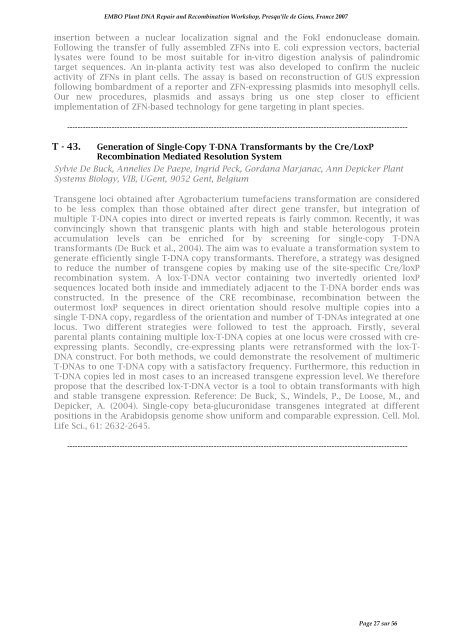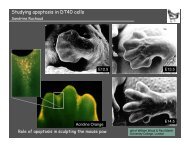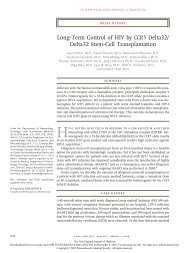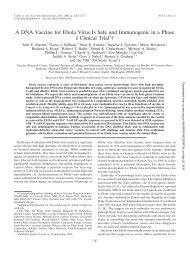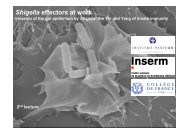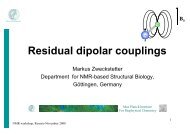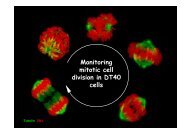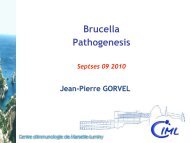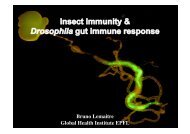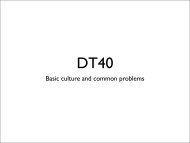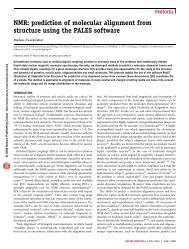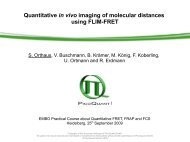pdf file - Events - EMBO
pdf file - Events - EMBO
pdf file - Events - EMBO
Create successful ePaper yourself
Turn your PDF publications into a flip-book with our unique Google optimized e-Paper software.
<strong>EMBO</strong> Plant DNA Repair and Recombination Workshop, Presqu'île de Giens, France 2007<br />
insertion between a nuclear localization signal and the FokI endonuclease domain.<br />
Following the transfer of fully assembled ZFNs into E. coli expression vectors, bacterial<br />
lysates were found to be most suitable for in-vitro digestion analysis of palindromic<br />
target sequences. An in-planta activity test was also developed to confirm the nucleic<br />
activity of ZFNs in plant cells. The assay is based on reconstruction of GUS expression<br />
following bombardment of a reporter and ZFN-expressing plasmids into mesophyll cells.<br />
Our new procedures, plasmids and assays bring us one step closer to efficient<br />
implementation of ZFN-based technology for gene targeting in plant species.<br />
----------------------------------------------------------------------------------------------------------------------------------<br />
T - 43. Generation of Single-Copy T-DNA Transformants by the Cre/LoxP<br />
Recombination Mediated Resolution System<br />
Sylvie De Buck, Annelies De Paepe, Ingrid Peck, Gordana Marjanac, Ann Depicker Plant<br />
Systems Biology, VIB, UGent, 9052 Gent, Belgium<br />
Transgene loci obtained after Agrobacterium tumefaciens transformation are considered<br />
to be less complex than those obtained after direct gene transfer, but integration of<br />
multiple T-DNA copies into direct or inverted repeats is fairly common. Recently, it was<br />
convincingly shown that transgenic plants with high and stable heterologous protein<br />
accumulation levels can be enriched for by screening for single-copy T-DNA<br />
transformants (De Buck et al., 2004). The aim was to evaluate a transformation system to<br />
generate efficiently single T-DNA copy transformants. Therefore, a strategy was designed<br />
to reduce the number of transgene copies by making use of the site-specific Cre/loxP<br />
recombination system. A lox-T-DNA vector containing two invertedly oriented loxP<br />
sequences located both inside and immediately adjacent to the T-DNA border ends was<br />
constructed. In the presence of the CRE recombinase, recombination between the<br />
outermost loxP sequences in direct orientation should resolve multiple copies into a<br />
single T-DNA copy, regardless of the orientation and number of T-DNAs integrated at one<br />
locus. Two different strategies were followed to test the approach. Firstly, several<br />
parental plants containing multiple lox-T-DNA copies at one locus were crossed with creexpressing<br />
plants. Secondly, cre-expressing plants were retransformed with the lox-T-<br />
DNA construct. For both methods, we could demonstrate the resolvement of multimeric<br />
T-DNAs to one T-DNA copy with a satisfactory frequency. Furthermore, this reduction in<br />
T-DNA copies led in most cases to an increased transgene expression level. We therefore<br />
propose that the described lox-T-DNA vector is a tool to obtain transformants with high<br />
and stable transgene expression. Reference: De Buck, S., Windels, P., De Loose, M., and<br />
Depicker, A. (2004). Single-copy beta-glucuronidase transgenes integrated at different<br />
positions in the Arabidopsis genome show uniform and comparable expression. Cell. Mol.<br />
Life Sci., 61: 2632-2645.<br />
----------------------------------------------------------------------------------------------------------------------------------<br />
Page 27 sur 56


